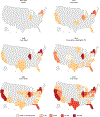Worsening Spread of Candida auris in the United States, 2019 to 2021
- PMID: 36940442
- PMCID: PMC11307313
- DOI: 10.7326/M22-3469
Worsening Spread of Candida auris in the United States, 2019 to 2021
Abstract
Background: Candida auris is an emerging fungal threat that has been spreading in the United States since it was first reported in 2016.
Objective: To describe recent changes in the U.S. epidemiology of C auris occurring from 2019 to 2021.
Design: Description of national surveillance data.
Setting: United States.
Patients: Persons with any specimen that was positive for C auris.
Measurements: Case counts reported to the Centers for Disease Control and Prevention by health departments, volume of colonization screening, and antifungal susceptibility results were aggregated and compared over time and by geographic region.
Results: A total of 3270 clinical cases and 7413 screening cases of C auris were reported in the United States through 31 December 2021. The percentage increase in clinical cases grew each year, from a 44% increase in 2019 to a 95% increase in 2021. Colonization screening volume and screening cases increased in 2021 by more than 80% and more than 200%, respectively. From 2019 to 2021, 17 states identified their first C auris case. The number of C auris cases that were resistant to echinocandins in 2021 was about 3 times that in each of the previous 2 years.
Limitation: Identification of screening cases depends on screening that is done on the basis of need and available resources. Screening is not conducted uniformly across the United States, so the true burden of C auris cases may be underestimated.
Conclusion: C auris cases and transmission have risen in recent years, with a dramatic increase in 2021. The rise in echinocandin-resistant cases and evidence of transmission is particularly concerning because echinocandins are first-line therapy for invasive Candida infections, including C auris. These findings highlight the need for improved detection and infection control practices to prevent spread of C auris.
Primary funding source: None.
Conflict of interest statement
Figures



References
-
- Centers for Disease Control and Prevention. Antibiotic Resistance Threats in the United States, 2019. Centers for Disease Control and Prevention; 2019. doi:10.15620/cdc:82532 - DOI
MeSH terms
Substances
Grants and funding
LinkOut - more resources
Full Text Sources
Medical
